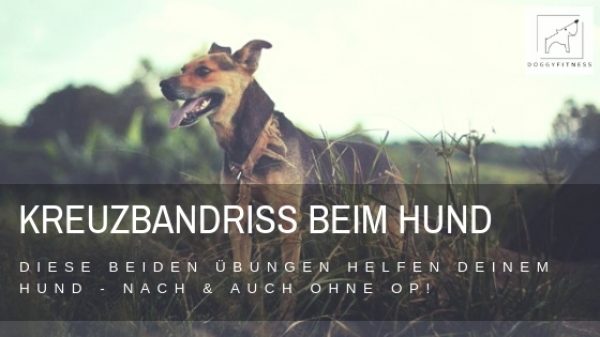These exercises will help your dog with cruciate ligament tear
Cruciate ligament rupture in dogs was the topic of my last blog post. There I introduced you to the clinical picture and explained the consequences for your dog. Today I’m going to tell you about two good exercises you can do to help a dog with a torn cruciate ligament. With the exercises you specifically train the affected muscles, a normal movement sequence, mobility and coordination. Many dogs are reluctant to put weight back on the affected leg after a cruciate ligament tear. These two exercises are specifically designed to regain confidence in loading the leg.
The first exercise is the slalom
And this is how it works:
You need 4-5 obstacles for the exercise to get your dog into a flow of movement. At home, for example, you can fall back on small stacks of books. In the garden are suitable flower pots. The important thing is that they should not be too small so that your dog is not tempted to jump over them. You build the slalom obstacles in a straight line on level ground. The distance is optimal with about a dog’s length. Now slowly lead your dog around the obstacles on a short leash. Is your dog very excited? Then let him dismount briefly before going around the obstacles. The whole thing should happen as slowly as possible. This is the only way your dog’s brain internalizes what the correct and healthy movement should be. And very importantly, praise the dog when he has done it right. When you reach the end, let your dog sit again for a short time before heading back.
I recommend you do the exercise once a day with two repetitions each.
The effect
With slalom training you train agility, a normal flow of movement and coordination. Your dog shifts his weight from one half of his body to the other, putting equal weight on his legs. Confidence and awareness in his body are improved. The muscles of all four legs and the back are strengthened.
Additional effect: When dismounting at the beginning and at the end of the run, your dog additionally trains the bending and stretching of the knee.
The second exercise is the “paw lift”
And this is how the exercise works:
Your dog stands on a non-slip surface and you squat next to your dog. That way you can prop him up if he gets off balance. You grab the front leg (above the paw), lift it slightly and unload the leg for about 3-5 seconds. On the hind legs, you also grab above the paw, bending the barrel slightly. Just like you do when you dry your dog’s paw. Even if the exercise looks simple, the effect and effort are high, especially if your dog has a weak point in the musculoskeletal system.
Start with two repetitions per run twice a day. The duration of the hold can be increased up to 15 seconds and you can also increase the repetitions.
The effect
You strengthen with the exercise, the muscles of the runs and train the coordination of your dog. This is because every time you lift one of the three healthy legs, the dog is putting weight on the leg that is weakened by the cruciate ligament tear.
Extra tip for your dog with cruciate ligament tear
If your dog does not want to put weight on his little foot after a cruciate ligament rupture, put a hair tie around the affected hind leg (above the paw) of the affected hind leg. This makes him aware of his leg and helps him use all four legs again.
Always consider your dog’s daily form during your training sessions. Even your dog is not in the same good mood and performance every day.
Let’s go! Have fun training with your dog! Do you have questions about the exercises or would you like tips on other medical conditions? Then feel free to write me a comment or a message!
Dieser Beitrag ist auch verfügbar auf:
Français (French)
Deutsch (German)
Español (Spanish)















